2022 Rivian R1T First Drive - The Next Electric Benchmark
Here's a spoiler: the 2022 Rivian R1T is really, really good. Not just "good for the first attempt of a brand new automaker," or even "good for one of the first all-electric pickups," but just really good, period. For a truck that once seemed almost certainly destined for the vaporware pile, that's frankly astonishing.
It's less than four years since Rivian burst out of stealth at the LA Auto Show 2018, debuting not only the R1T but its SUV sibling, the R1S, too. Back then you'd have been forgiven for harboring doubts: after all, Rivian wasn't holding back on the promises.
The R1T would have more than 800 horsepower, and over 900 lb-ft of torque. It would seat five, tow up to 11,000 pounds, and have a full four electric motors, one for each wheel. Courtesy of a entirely custom platform it would offer storage in places no other pickup had managed, while it still delivering over 300 miles of range.
Oh, and it would start at under $70,000, before the US federal tax incentive.
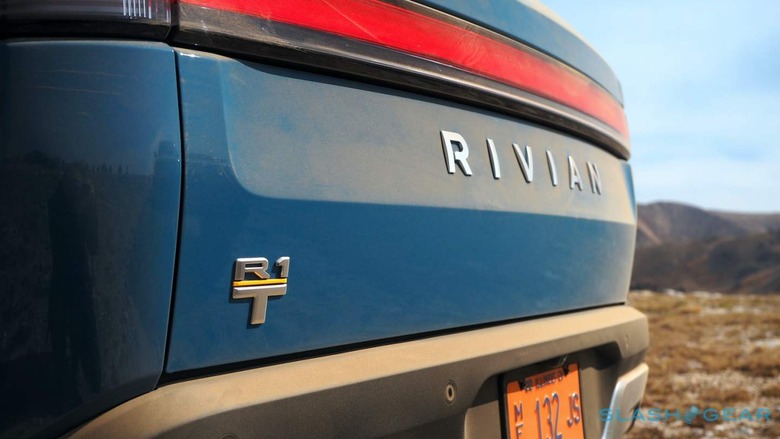
Fast forward to today and, though you can critique Rivian's timeliness – the R1T was originally intended to ship in late 2020, whereas the first examples are actually rolling off to the earliest reservation-holders right now – the electric pickup delivers on those commitments. More than that, though, it does so in a way that belies the automaker's youth and the truck's price.
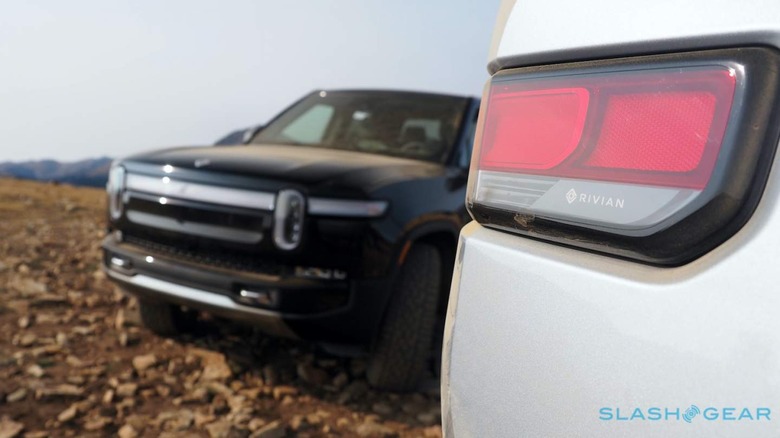
Though its silhouette may be familiar, the R1T's detailing sets it apart on the road. There's a commendable restraint to Rivian's style: not a characterless, amorphous blob designed to satisfy the wind tunnel, but not a desperately stylized attempt to grab attention, either. From the front, the upright lamp clusters that intersect with the fascia-spanning light bar are the most dramatic element, lending the truck an unmistakable signature in your rearview mirror (even if they do look a little like overgrown eyeteeth).
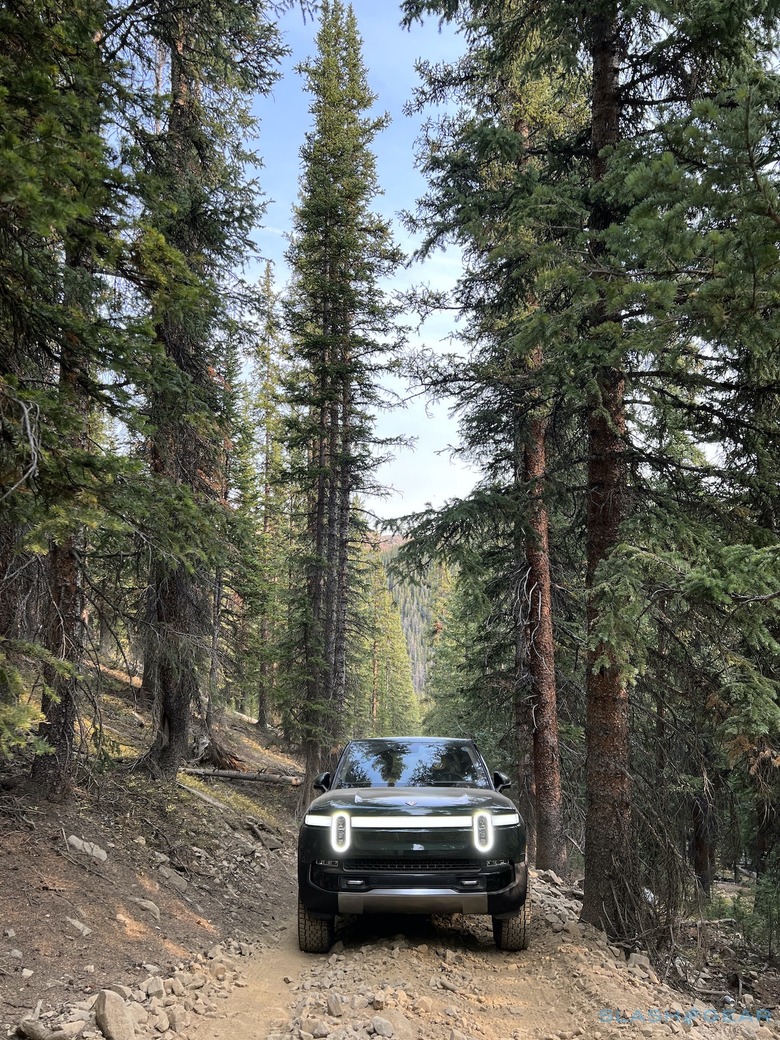
In profile, the pickup lacks the obvious join-lines that punctuate other trucks; the whole thing has a fluid solidity. At the rear, strong wheel arches combine with slightly tapering hips for a planted appearance, finished with another full-width light cluster. Those lights are functional beyond just driving, too, glowing to indicate charge status when the R1T is plugged in.
Throw in the 20-inch wheels that come standard on the R1T Launch Edition, and the end result is modern without seeming over-exaggerated. It absolutely turns heads, too.
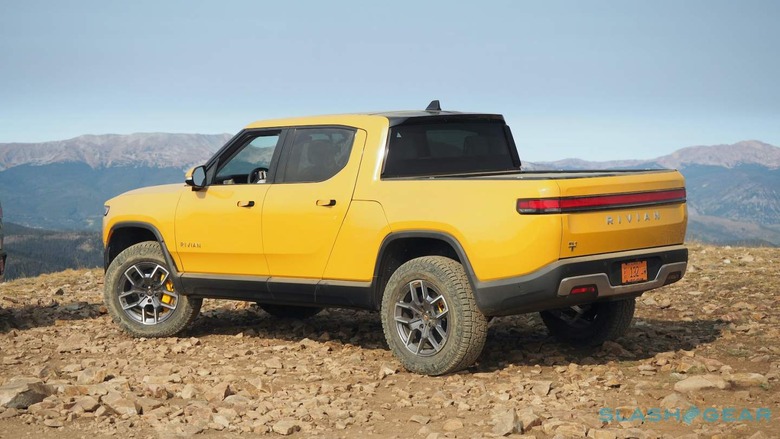
For practicality, there's a 4'6 (54 inch) long bed that holds just north of 29 cu-ft, and with a further 14.3 cu-ft of lockable underbed storage (enough for a full-size spare). A clever hinged panel makes for a flat load floor with the tailgate down, extending the bed to almost 84 inches, albeit open at the back. The Adventure Package adds a powered tonneau cover that motors into place to leave the bed weatherproof.
Two 15-amp, 120V AC outlets are back there, too, plus built-in lights, heavy-duty tie-downs, and an integrated air compressor that can deliver up to 150 psi. It comes with a 20 foot hose so as to easily reach all four wheels, but could just as easily inflate beach toys.
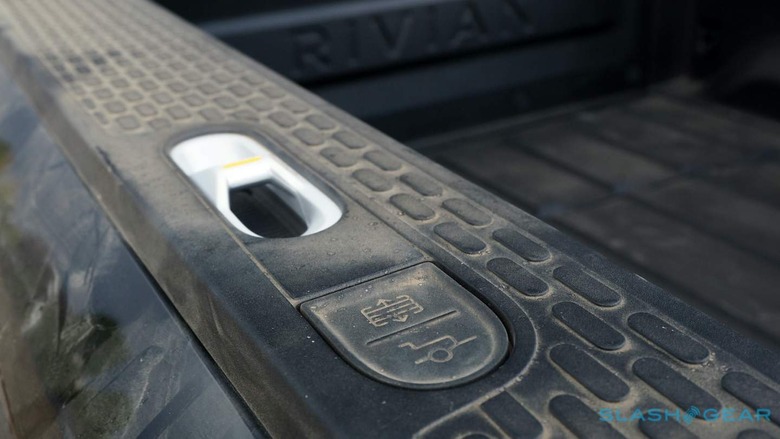
The front trunk has 11 cu-ft more storage, with a lower compartment where the portable charger lives. It's accessed via a power lid, has LED lighting and a 12V outlet (though no 120V option), and there's a drain plug so you could fill the whole thing with ice as a massive cooler, or hose it down after storing muddy gear. Where the tailgate and tonneau cover have easily-stabbed buttons on the bed rails, though, the front trunk's button is hidden under the edge of the fascia and a little tricky to find. You can, of course, open it via the key fob, the dashboard touchscreen, or via the Rivian app.
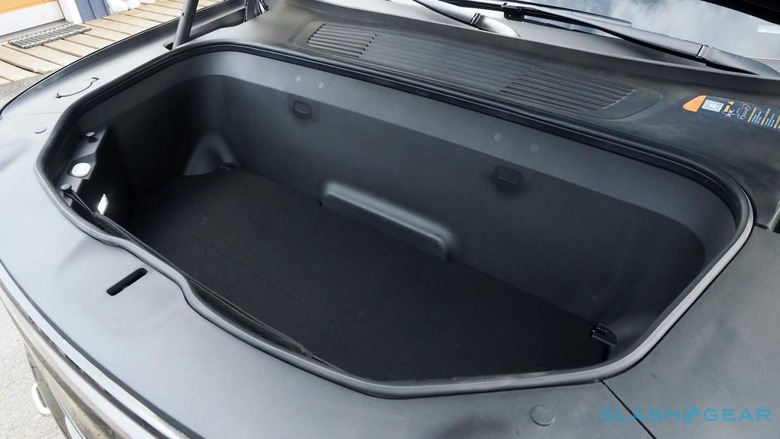
Finally, and unique, is the Gear Tunnel. It runs the full width of the R1T, behind the cabin: 65-inches across, 11.6 cu-ft in total, and a mechanical impossibility had this been a traditional, gas or diesel truck. There are access doors on both sides – they hinge down, can each support up to 300 pounds, and have hidden storage compartments – along with LED lighting inside, plus 120V and 12V outlets. A roll-down door behind the rear armrest allows for passthrough access.
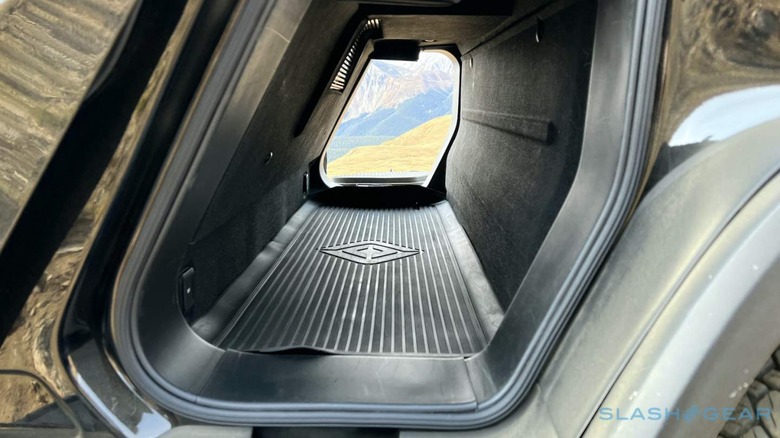
You can fill it with bags, golf clubs, or even suitably-sized skis, or you can spend $5,000 on Rivian's Camp Kitchen. Two units – one with a dual induction burner cooktop, the other with a collapsable sink and a 4 gallon water tank – mount onto a slide-out shuttle rail, complete with drawers for a matching 30-piece Snow Peak kitchen set that includes everything from knives and forks, through to a coffee grinder and charcuterie board.
Everything is powered from the R1T itself, or you can detach the two modules to use the Gear Tunnel for regular storage. Rivian says the idea came from observing how overlanding enthusiasts developed DIY mobile kitchens for their vehicles, only here built to the same standard as the rest of the EV. The same goes for the $2,650 three-person Yakima tent, which mounts to removable crossbars on top of the truck and includes a collapsable ladder.
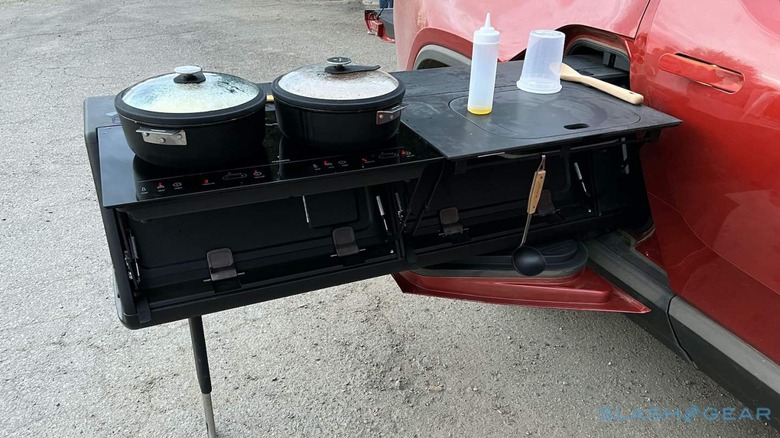
Overall, the R1T promises more than 68 cubic feet of total storage, including the various cabin bins. Not bad at all for a pickup that doesn't have the 5 or 6 foot bed many buyers are looking for (Rivian won't be drawn on any possibility of another size later on, though you'd have to imagine the automaker is at least considering it).
All that practicality would be for naught, were the R1T a disappointment from behind the wheel. In actual fact, the truck makes a more than convincing argument that electric is the natural next evolution of the pickup, with Rivian setting the bar high for the gush of similar EVs we're expecting over the next few years.
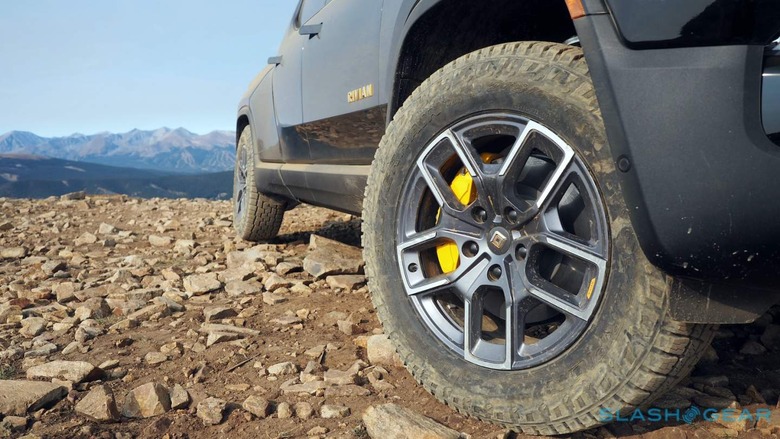
Each wheel has its own electric motor, independent air suspension and active damping are standard, and there's an electro-hydraulic roll control system that Rivian benchmarked against the similar tech you'd find in a McLaren. The two front motors deliver 415 horsepower in total, and 413 lb-ft of torque; the rear pair contribute 420 horsepower and 495 lb-ft. Total system power is dependent on how the R1T routes juice from its battery, but figure on over 800 hp and over 900 lb-ft.
Big numbers, but it's how the truck puts power down to the ground that's particularly special. There's true torque vectoring, Rivian's software directing power to each individual wheel depending on which has the most traction. In high-speed corners, the outer wheels can be driven faster than the inner wheels, tightening the turn. Off-road, the tire with the greatest grip can help pull the R1T out of muddy situations.
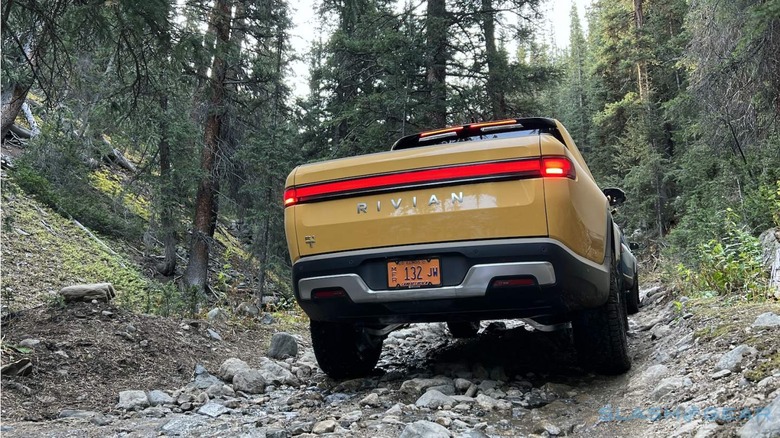
Ride height can drop as low as 7.9 inches, or as high as 14.4 inches, for a functionally (and visually) huge 6.5 inches of adjustment. Variable damping rates finesse to the condition of the road, while the roll control system can flick between sports car taut and mud-plugger flexible.
Building a truck – building a successful truck, anyway – involves straddling two worlds. First, one where unreliable surfaces and unpredictable conditions – whether that be the side of a mountain or a job site – are the norm. Then there's on-road, where pickups are increasingly expected to hold their own against mainstream vehicles in comfort and refinement.
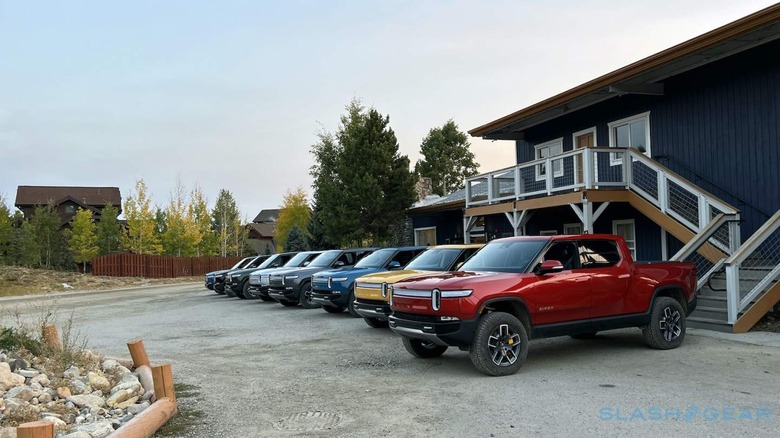
To demonstrate the R1T's talents at the former, Rivian invited me out to Breckenridge, Colorado. Poised at the base of the Rocky Mountains' Tenmile Range, it proved to be the perfect staging point for a morning of off-roading.
Now, automaker "off-road demonstrations" are a varying thing. Anything from a few staged logs and rocks to showcase suspension articulation, to the trip across the 12,600+ foot high Continental Divide that our convoy of electric trucks followed. Weaving through switchbacks, tiptoeing through rock crawls, and seemingly balancing on the knife-edge trails between sprawling vistas.

It's a route, the local park ranger explained, that they often discourage off-roaders from tackling, yet the R1T took it in its stride. There are five drive modes: All-Purpose, intended for the road; Sport, with the most potent settings; Conserve, maximizing range by only using the front motors; Towing, for stability when there's something hitched to the back; and finally Off-Road.
Off-Road mode actually has three settings of its own: Auto, Rock Crawl prioritizing clearance and traction as you navigate across unruly surfaces, and Rally for higher-speed driving. In each mode, you can individually adjust the ride height across five levels.
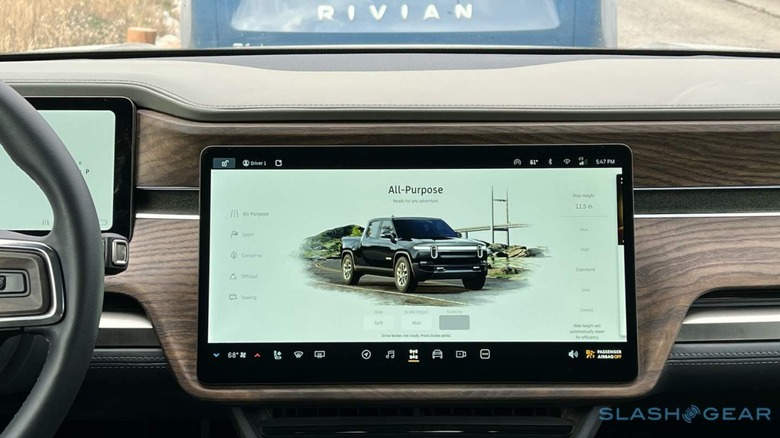
Missing, at this point, is Rivian's much-vaunted Tank Turn feature. With that, the R1T can effectively spin on the spot, though it'll be one of the talents coming later via an OTA update.
Despite its absence, the electric pickup didn't need any help. The combination of a nearly-flat underbody – without the dangling protrusions of driveshaft or differentials – and all that individual wheel articulation, along with instantaneous torque, makes navigating uneven terrain straightforward. The R1T boasts a 34-degree approach angle, over 29-degree departure angle, and almost 26-degree breakover; it'll ford up to 42.7 inches of water. Throw in the 20-inch Pirelli Scorpion All-Terrain rubber and you've got some serious grip, too.
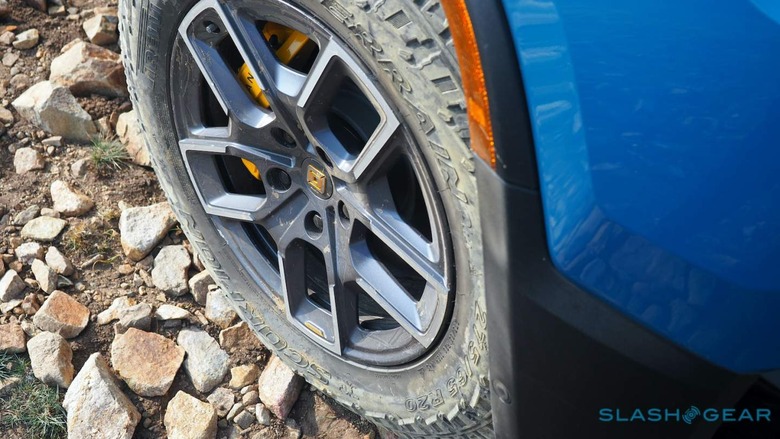
It's the regenerative braking that makes the off-roading experience almost video-game-easy, though. There are three levels of regen to choose from, each slowing the truck as you lift off the accelerator. We usually think of one-pedal EV driving as intended for urban settings, but it's even more convenient when trying to modulate speed as you're creeping over boulders or at dash-tilting angles.
Conventional trucks often have hill descent modes, but the R1T doesn't need that: you can do it all on the fly by adjusting the pressure of your right foot. Rivian doubles-down on the video game feel with 360-degree cameras, including wheel-specific close-ups; handy, since the slab-sided proportions mean there are some inevitable blindspots.
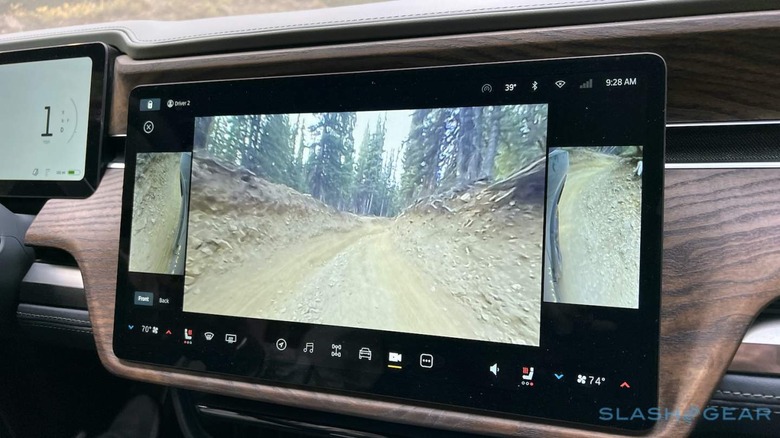
Altogether, though, it's hard not to conclude that electrification is probably the future of off-roading. Beyond just how straightforward that EV drivetrain makes the process, there's an unexpected joy in surreptitiously moseying through the wilderness in near-silence. No engine noise, no vibrations; just the crunch of the tires and the uninterrupted sounds of the environment you set out to experience in the first place.
There are great gas-engined pickups that handle adventure well, of course, but they tend to be less civilized when back on the asphalt. Rivian's second surprise is how rapidly it changes personality when you switch to All-Purpose or Sport modes.
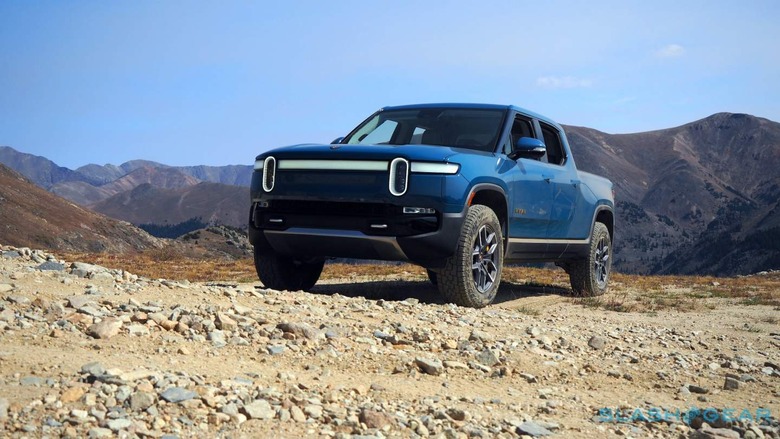
Then, the same air suspension which allowed for all that clambering hunkers down instead, with the trick roll-control system employed to keep the truck level in corners. The R1T may be no lightweight, but with a 0-60 mph time somewhere in the 3-4 second region it's deceptively fast. You'll get the best speed with the 22-inch all-season performance tire option, while the 21-inch all-season road tires are focused on range.
That's 314 miles at best, according to the EPA, with the R1T Large Pack. Switch to the off-road rubber and Rivian estimates a 10-15 percent dip: the truck's prediction was 270 miles. The largest sport wheels, meanwhile, could drop 5-10 percent off the total range.
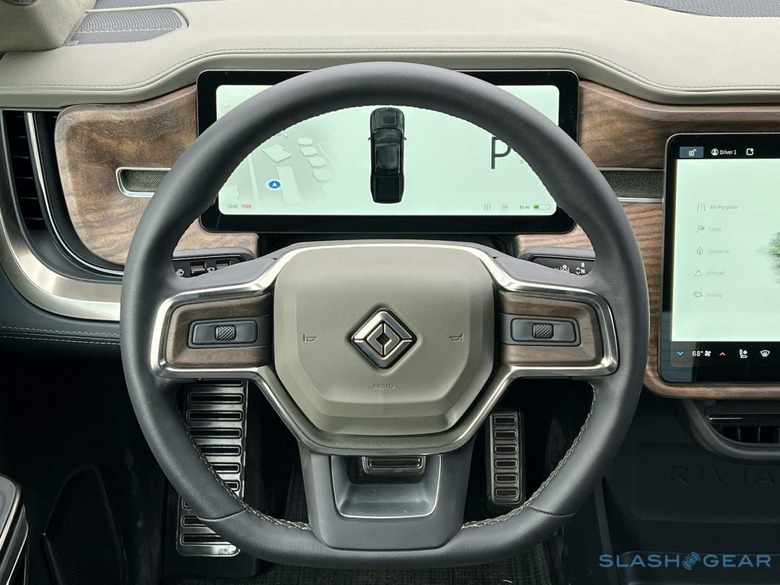
I didn't have the opportunity to test the accuracy of those numbers out; that'll have to wait until I've got more prolonged seat time. Still, they're competitive, both in the EV segment generally and from what we're expecting in electric trucks specifically. Ford's upcoming F-150 Lighting, for example, should offer around 300 miles of range with its Extended Battery option.
For charging, there's 200 kW DC fast charger support, the socket hidden behind a motorized cover on the front fender. Rivian has inked deals with third-party networks like ChargePoint and EVgo, so not only do their locations show up in the standard navigation but you can filter by charger speed and availability, too. The Rivian Network, meanwhile, will consist of the automaker's own chargers, focusing more on trailhead and adventure destinations.
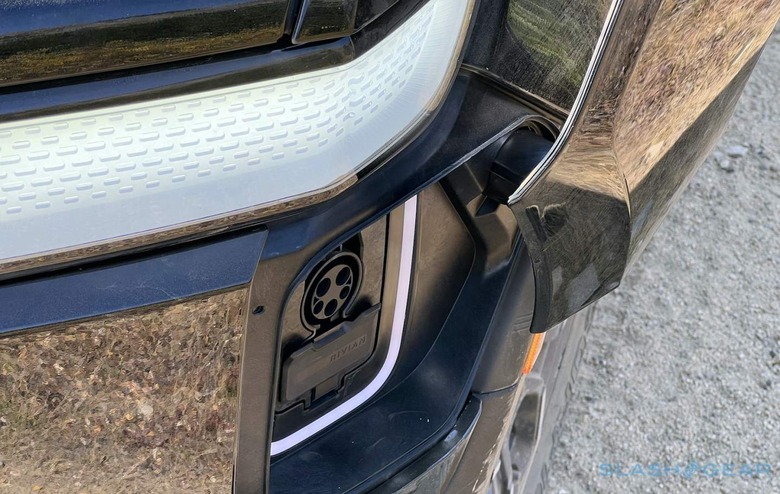
An embedded 4G LTE connection is standard, used for navigation, WiFi hotspot, Spotify and TuneIn streaming, OTA updates, and more. It also links the R1T with the Rivian app. From that, you can lock and unlock the truck, as well as monitor things like charging status. Rivian also includes NFC keycards and a carabiner-style key fob, and there's a waterproof NFC wristband option too.
Switchable driver profiles store not only seat, wheel, and mirror position, but favored media presets and other settings. For the moment that's all saved locally to the car, though Rivian says it's looking at a cloud-based system. Profiles also save sub-settings for individual drive modes: if you prefer medium regeneration and firm suspension when in All-Purpose mode, say, that will be stored as well.
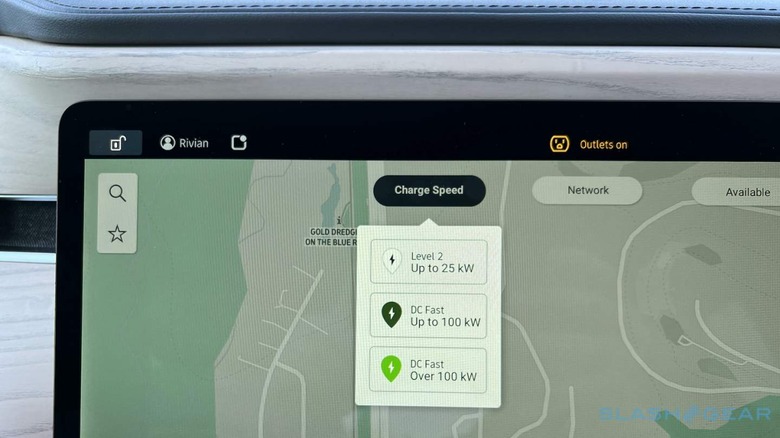
Everything's controlled with a large, 16-inch portrait-aspect touchscreen, running software of Rivian's own development. The UI is clean and sleek, organized into tabs for the main sections and with shortcuts for the most common features – like HVAC and the heated/cooled front seats – in a persistent bar along the bottom. Physical controls are kept to a minimum; even directing the air vents is done by dragging icons around the screen. I wish Rivian would relent and at least include a volume knob.
Key information is shown on the driver display: speed, range, navigation instructions, and a visualization of surrounding vehicles spotted by the EV's various sensors. Thumb controls on the steering wheel control media and Rivian's Driver+ driver-assistance system. A third, smaller touchscreen allows the back-seat passengers to control their own HVAC and seat heating.
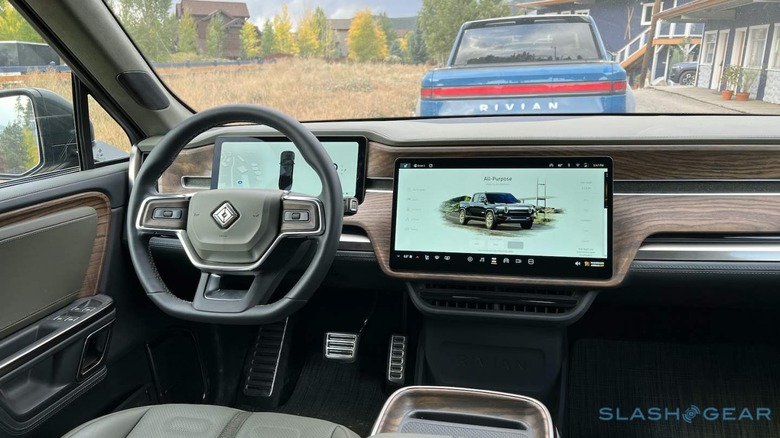
The R1T I was driving was pre-production, and a few glitches still needed ironing out. Occasionally sluggish touch-responses and vanishing controls suggest Rivian still has a little work to do there. More conspicuous by their absence, however, are Apple CarPlay and Android Auto.
For the moment, though the truck has a healthy six USB-C ports, and a Qi wireless pad that can simultaneously recharge two devices at once, plugging in your iPhone or Android won't get you their respective projection interfaces. You can stream music and calls via Bluetooth, but Rivian won't be drawn on when – or even if – it'll be adding the native interfaces.
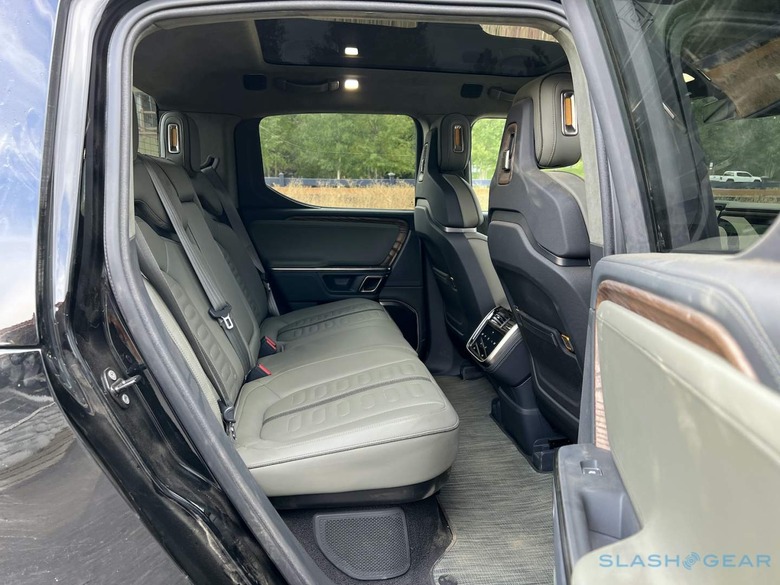
What is coming is embedded Alexa (Amazon is, it's worth noting, among Rivian's primary investors). With that, you'll be able to control multimedia, ask questions, search for destinations, and query things like battery and charge status by voice. Clever stuff but, even though Rivian's map app is pretty and seems flexible, you'll forgive me if I still prefer Google Maps.
Hopefully, the automaker relents and delivers some of those features – by this stage basically considered table-stakes by rivals – via the OTA system. It'll also use that to update and enhance Driver+, which for the moment offers a hands-on, Level 2 combination of adaptive cruise control and lane-keeping.
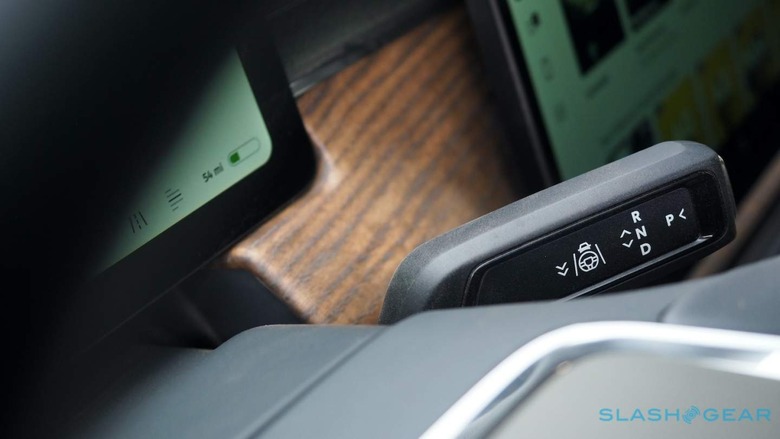
Tap the drive stalk down once for basic adaptive cruise: the wheel under your right thumb controls distance from the vehicle ahead, the buttons flanking it control speed. Once the gray Driver+ icon appears – which can take a while – double-tapping the stalk activates lane-keeping, too. Rivian tracks attention via both capacitive touch sensors in the wheel and a driver-facing camera positioned above the rearview mirror.
According to the company, it'll wait around 15 seconds before it nudges you to re-engage. That, Rivian tells me, may change over time as the system evolves. Most of the time the truck handled the curves of a highway just fine, though in some tighter turns it did prompt me to grip the wheel again preemptively, and there's no automatic lane-change yet though that's also in development.
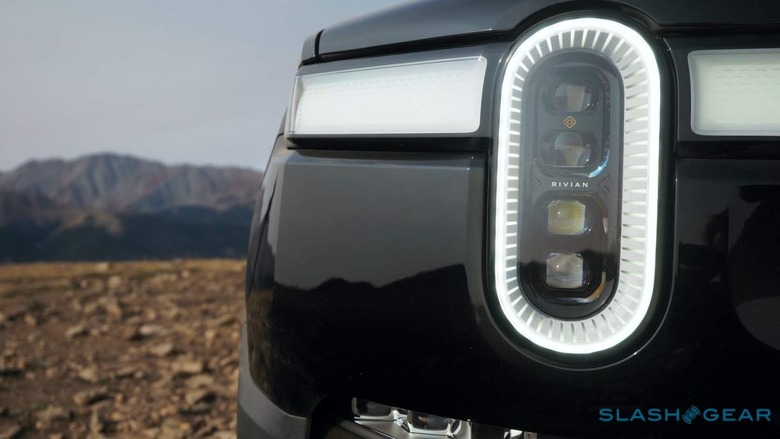
Lane-keeping assistance, blind spot warnings, lane departure warnings, rear cross-traffic alerts, trailer assist, forward collision warnings, automatic emergency braking, and dynamic brake support are all standard. So, too, is a 360-degree camera system. The R1T has around 45GB of onboard storage, which it can also use to capture video from the external cameras while parked; those clips auto-delete after a period, or can be saved for insurance purposes.
In theory, the R1T's 10 exterior cameras, five radars, and 12 ultrasonic sensors could turn their collective hand to something akin to a Level 3 assistance system. That's something Rivian talked about back in 2018, indeed, when it first showed off the truck. In practice, I get the feeling the automaker is in no real hurry to deliver that sort of functionality, preferring to nail the essentials first before wading into the morass that is the current state of "not quite autonomous" driving aids.
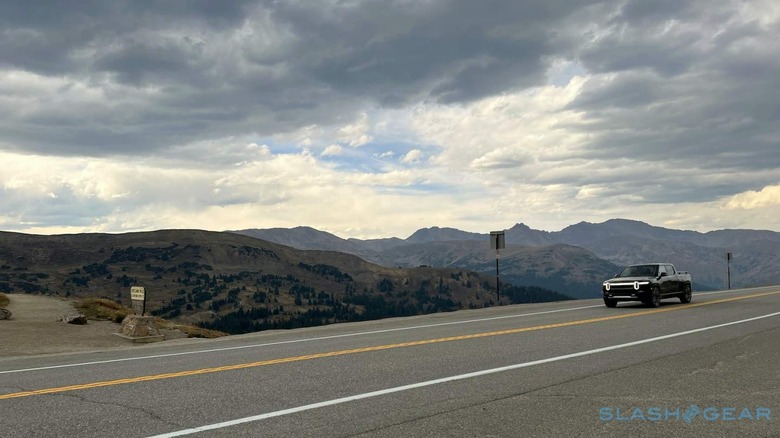
It's probably wise, and frankly the experience from behind the wheel of the R1T is no hardship. Rivian's well-equipped and beautifully made cabin is a core part of that, managing to feel suitably rugged while also combining high-end materials. Ash wood trim combined with vegan leather, recycled microfiber, and hose-friendly floor mats are offered in three finishes: Forest Edge, Black Mountain, and Ocean Coast.
The level of detailing was excellent, even on pre-production vehicles; I'd take this over any trim of pickup from Ford, GM, or Ram, quite frankly. Modern, without feeling obnoxiously so.
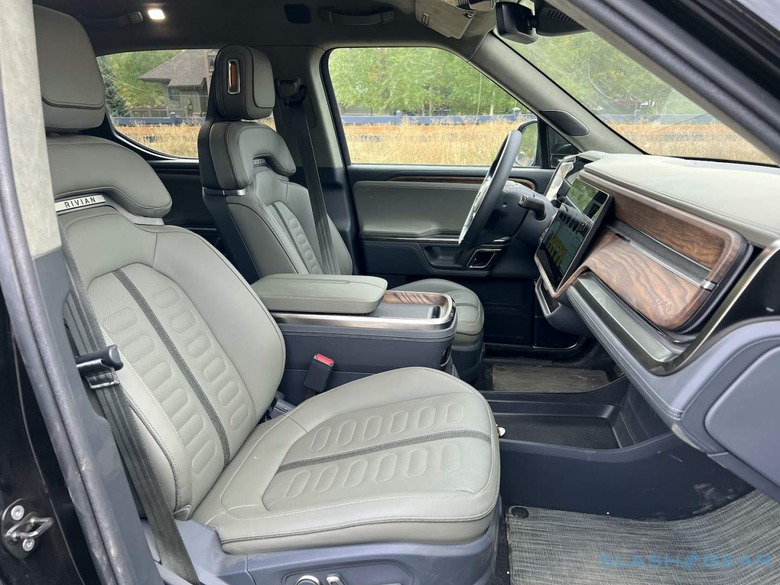
Again, the magic is in the more playful features. The Camp Speaker – a rechargeable Bluetooth speaker with built-in mood lighting that docks under the center armrest – for example, or the Torch Flashlight that pops out of the driver's door and is kept topped-up from the R1T's own battery. The 18-speaker 1,200W Rivian Elevation by Meridian audio system punches well above what most pickups offer, too.
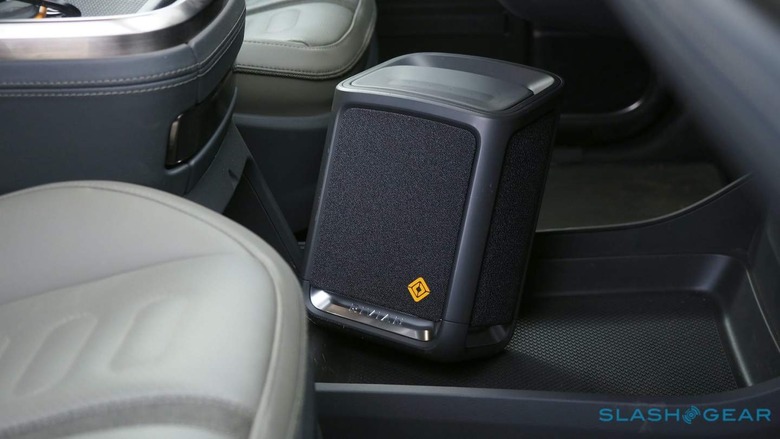
It's standard on the sold-out R1T Launch Edition (from $73,000), deliveries of which are beginning now, and on the nearly-identical R1T Adventure trim which is priced the same. Deliveries of that, and the entry-level R1T Explore (from $67,500) – which has a manual tonneau cover, non-heated/ventilated seats, and a standard audio system, but the same Large Pack battery – start in January 2022.
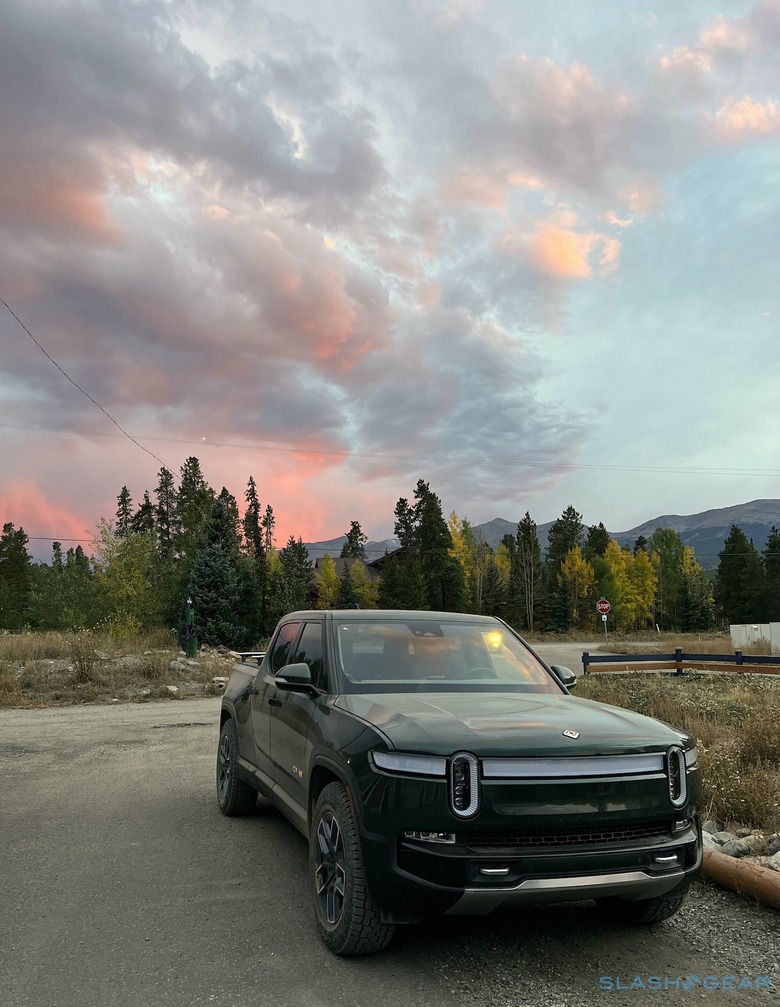
That is, assuming you got your reservation in early. Place an order today, and you're looking at mid to late 2022 before you get your R1T, Rivian warns. Honestly, that's the most disappointing part of the whole EV.
2022 Rivian R1T Verdict
Rivian could've taken a relatively easy route with the R1T: made a great pickup, and settled for average elsewhere. Truck drivers are, after all, more than willing to accommodate mediocre on-road manners for a vehicle that delivers off the asphalt. The R1T's refusal to compromise in either condition not only goes above and beyond what many of its far more established rivals are offering in their dealerships, it foreshadows just how impressive the fast-approaching R1S will be in the fiendishly competitive SUV segment.
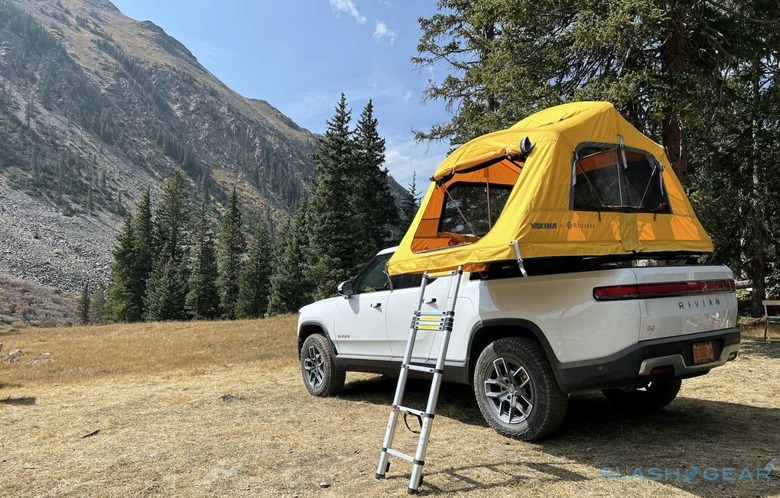
What stands out most, though, is how compelling an all-rounder the R1T is. This does not look, drive, or feel like the first attempt from a brand new automaker, and the sticker price – particularly after that $7,500 federal incentive – is astonishingly aggressive.
At the same time, Rivian's clear focus doesn't mean the company has done the bare minimum. Extras like the Camp Kitchen are evidence of that: novelties, sure, but which betray a deep understanding – and appreciation – of the R1T's target audience. This isn't "minimum viable product" but, rather, a thoughtful reconsideration of just what can be achieved when you don't have a traditional combustion platform to accommodate. The 2022 Rivian R1T may be the first of many all-electric trucks, but it sets an impressively high bar by which those that follow will be judged.
